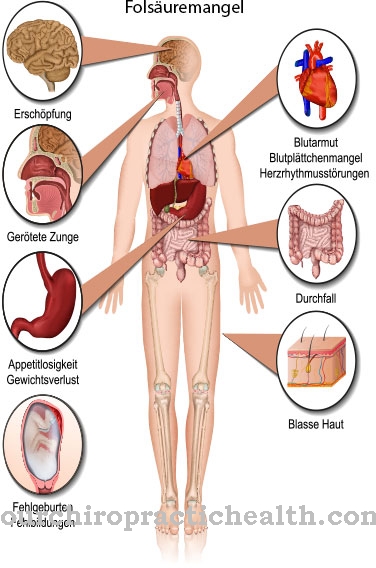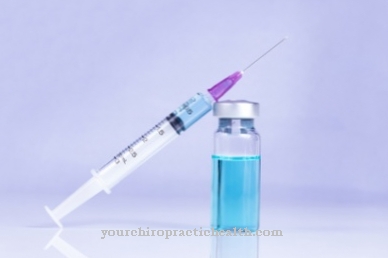Under the term Angiosarcoma the doctor summarizes various malignant tumors of the skin's vascular system. Angiosarcoma usually only occurs in people of advanced age (around 65 to 75 years of age), often after cancer treatment has already taken place. The prognosis for angiosarcoma is rather poor.
What is an angiosarcoma?

© logo3in1 - stock.adobe.com
Angiosarcoma is very rare. Around 1-2% of all new cancer cases are soft tissue tumors, new angiosarcoma cases are correspondingly even rarer.
It almost exclusively affects older people; women are affected somewhat more often than men. An angiosarcoma usually shows up after cancer treatment with radiation therapy, usually after treatment of breast cancer with a subsequent total operation. In about 30% of all cases, an angiosarcoma first occurs in the area of the neck and head.
There are red spots that turn bluish after a short time and "disintegrate" into tiny tumors in the further course. Especially at the beginning the spots are often misinterpreted and wrongly e.g. diagnosed with hives or bruises.
causes
According to the current state of research, an angiosarcoma occurs more frequently after tumor treatment with subsequent radiation therapy. In particular, there is a clear connection between the occurrence of a breast cancer with subsequent (ionizing) radiation therapy.
People with persistent lymphedema are also more likely to develop angiosarcoma. The cause can also be poisoning with some toxic substances, such as arsenic, vinyl chloride and Thorotrast (contrast media). A body that is immunocompromised by certain viruses also favors the development of an angiosarcoma.
Kaposi's sarcoma, which belongs to the family of angiosarcomas and mostly affects people who suffer from HIV infection or AIDS, is well known. It is particularly significant that skin that has been repeatedly damaged by the sun tends to develop angiosarcoma significantly more frequently than skin that has not been exposed to any particular exposure to UV rays.
Symptoms, ailments & signs
Angiosarcoma can manifest itself through a variety of symptoms. Typically there is reddening of the skin and skin changes. Most patients suffer from bruises and ulcers, which often appear all over the body and can cause accompanying symptoms such as pain and itching. An angiosarcoma can also lead to swelling of the upper abdomen, combined with a feeling of pressure in the affected area.
Whether further signs appear depends on the size and location of the tumor. Smaller sarcomas can often only be recognized by the presence of small raised skin and nodules under the skin that hurt when you apply pressure. Larger tumors can damage the tissues of the skin, causing injury and bleeding. In less severe cases, angiosarcomas lead to hardening in the surrounding tissue. The skin then feels leathery and is less sensitive to pain.
The tumor itself hurts to the touch, especially if it is located in the genital area, in the area of the face or in other sensitive areas. Occasionally there is pain or gastrointestinal complaints. If an angiosarcoma is not treated, general symptoms such as fever and nausea can develop. As the disease progresses, the physical and mental well-being of those affected decreases significantly.
Diagnosis & course
If the suspicion of angiosarcoma is confirmed, the doctor will first try to take an anamnesis to find out whether the patient was exposed to the typical sources of danger.
He will then do a biopsy, i.e. remove tissue from the affected tumor.A laboratory doctor will confirm the suspicion of an angiosarcoma after a cytological examination of the sample. The course of the cancer is rather unfavorable.
Since an angiosarcoma is initially not noticed or, in many cases, is initially not correctly diagnosed, but at the same time it spreads very quickly over the blood vessels of the skin and forms metastases in many vital organs, it is difficult to treat. The 5-year prognosis is around 10% (the 5-year prognosis indicates how many of the patients with a certain disease are still alive (tumor-free) after 5 years).
Complications
The prospects for illness with angiosarcoma are generally poor. Only up to a maximum of 24 percent of patients survive the first five years after the operation. The thickness of the tumor plays an important role. If the sarcoma is smaller than five centimeters, the prognosis can be somewhat more positive than for large flat tumors that start from different parts of an organ and spread from there.
Age is also decisive. The older the patient, the lower their chances of survival. The prognoses for angiosarcoma, which spreads from the blood vessels to the areas along chronic lymphedema, a lymphedema-associated angiosarcoma or Stewart-Trèves syndrome are even worse.
The causes of death here are metastases in the lungs, pleura and chest. The prognoses for angiosarcoma in the breast and post-radiation angiosarcoma are worst. With a tumor in the breast, the chances of survival are only about ten percent. In most cases, life expectancy is a little less than two years. In the case of tumors in the soft tissues, 50 percent of those affected unfortunately do not survive the first time, fortunately, of the other half, almost 34 percent reach the fourth year after the operation.
When should you go to the doctor?
If you have angiosarcoma, you should see a doctor straight away. Since this is a cancer, early diagnosis and treatment is very important so that consequential damage can be prevented and the person affected does not die. In most cases, an angiosarcoma manifests itself as severe reddening of the skin and the formation of bruises.
Should these complaints arise, a doctor must be consulted in any case. If there is swelling in the upper abdomen, a doctor should be noted immediately, as this could be cancer. As a rule, a dermatologist or a general practitioner can be consulted directly. Further treatment usually has to take place in a hospital.
The dermatologist himself can remove the affected skin areas. Chemotherapy may also be necessary for the person concerned so that the cancer does not spread to other parts of the body. Life expectancy is reduced by angiosarcoma.
Doctors & therapists in your area
Treatment & Therapy
The skin areas that show clear signs of angiosarcoma are radically removed by a dermatologist. However, an excision can only be made if the relevant skin areas are not too large, as otherwise the skin would not be able to close properly.
The removal is followed by radiation therapy in combination with chemotherapy. Radiation and chemotherapy are designed to prevent any remaining tumor cells from growing and spreading again. Subsequent immunotherapy can be sought.
Despite the available therapies, the prognosis is unfavorable, since the rapidly spreading angiosarcomas have often already affected organs such as the liver and the spleen. In addition, even after radical excision, new sarcomas (recurrence) form quite quickly, which in turn then respond less well to medication.
Outlook & forecast
The chances of recovery from angiosarcoma are very slim. The symptoms mostly occur in people over 65 years of age. The organism is already weakened at this point due to age. In most cases, various previous illnesses have existed for years and the body does not have the necessary resources for the necessary healing process.
In addition, angiosarcoma is a sequela of cancer. This means that in most cases the body is also weakened by an operation and subsequent cancer therapy. The month-long treatment leads to a reduction in muscle strength and defenses and is associated with numerous side effects.
On its own, there is a lack of antibodies to cure the angiosarcoma. In addition to the low existing physical self-healing powers, fatigue, discouragement and a lack of mental strength are also to be expected. This is also not very beneficial for the healing process.
A positive outlook on life, optimism and goals in life are fundamental points in recovery. About 1/3 of all people who have had radiation therapy suffer from angiosarcoma. With the current medical options for treatment, almost all cases lead to a fatal course of the disease with no prospect of a cure.
prevention
Angiosarcoma cannot be prevented. Patients who have been successfully treated for an angiosarcoma must then receive close care. It is recommended that a check-up be carried out about every three months.
Patients with a relevant pre-existing illness or patients who are frequently exposed to toxic substances or who have frequently suffered sunburn should critically examine their skin themselves or consult a dermatologist regularly. At the first signs of angiosarcoma, the patient should definitely report the suspicion to the attending physician.
Otherwise, the general rules apply, which everyone can follow to prevent cancer as much as possible. These include moderate use of nicotine and alcohol and a healthy diet.
Aftercare
If the angiosarcoma is treated successfully, it is followed by close follow-up care. Doctors recommend a check-up every three months. Diagnosis is based on clinical and histological findings. A single cure does not result in immunity. As with other tumor diseases, patients can organize their everyday lives in such a way that they do not occur again.
This includes avoiding nicotine, alcohol and other intoxicating substances. A healthy and balanced diet should be a matter of course. Low physical stress should be integrated into everyday life. In addition to the medical checks, the patient has a high level of personal responsibility.
This also extends to a regular critical examination of the skin surface. Consult a doctor immediately at the first signs of recurrence. Realistically, it should be noted that aftercare has little chance of success. After five years, only ten to twelve percent of the sick are still alive.
After a diagnosis, those affected should therefore deal with existential questions. It is not uncommon for new sarcomas to develop that spread to other parts of the body. Relatives should be prepared to take care of a nursing case. The domestic conditions must be adapted. A nursing service is to be commissioned.
You can do that yourself
If the typical skin changes or other symptoms of angiosarcoma are noticed, a doctor must be called in. There are several things the patient can do to aid in medical treatment and minimize the risk of complications.
First of all, strict personal hygiene applies. The area around the diseased skin areas is very sensitive and quickly becomes inflamed. For this reason, special care products from the drugstore should be applied in consultation with the doctor. Alternatively, there are preparations from nature, for example marigold ointment or lotions with chamomile or lemon balm.
Radiation therapy can be accompanied by a change in diet. The treatment usually leads to loss of appetite, which is why appetizing foods and drinks are recommended. However, stimulants such as alcohol or caffeine should be avoided. In addition, rest and bed rest apply.
To ensure that there are no recurrences, the patient must visit the doctor regularly for the first few weeks and months after treatment and have the skin examined. A complaint diary makes it easier for the doctor to set the medication. If there are serious side effects and interactions, the drug must be discontinued immediately.


.jpg)
.jpg)

.jpg)











.jpg)







.jpg)


